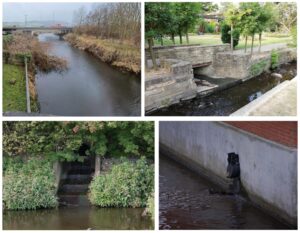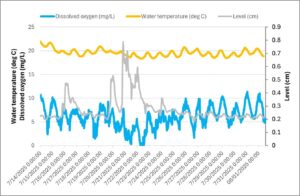Road network runoff impacts on river ecosystems
This project aims to advance understanding of the effects of road runoff on river ecosystems by studying water quality, biota and ecosystem process dynamics.
Despite long-term improvements in the quality of river ecosystems in the UK and Europe, many rivers and streams in the UK still fail to meet ‘good’ standards of ecological quality (Rivers Trust, 2024) and long-term biological recovery appears to have stalled in general across Europe (Haase et al., 2023). Much recent attention, particularly in England, has focused on the role of untreated sewage and wastewater effluent releases as key sources of pollution into rivers (e.g. HM Government, 2025; Yang et al., 2025). In contrast, the role of other urban stressors such as runoff from road/motorway networks, car parks, and other hardstanding areas currently receives far less attention from a scientific and regulatory perspective (BBC, 2024; CIWEM 2024).
 Fig. 1. Examples of rivers receiving runoff from roads and carparks in the River Aire catchment near Leeds, UK.
Fig. 1. Examples of rivers receiving runoff from roads and carparks in the River Aire catchment near Leeds, UK.
Road and motorway crossings are associated with an estimated 25,000 discharges into rivers in England alone just from routes managed by National Highways (Guardian, 2023), with tens of thousands additional storm drains on other parts of the road network (Fig. 1). These drainage systems are designed to remove water quickly from the road surface during rainfall events, but in doing so they often carry a diversity of pollutants including metals from vehicle brakes/corrosion (Beasley & Kneale, 2004), sediments/organic matter from drains/gutters, plastics, polycyclic aromatic compounds/PFAS, road salts (Szklarek et al., 2022), and chemicals from the degradation of tyres (Tian et al., 2021; Bohara et al., 2024). Road runoff can also impart thermal shocks into watercourses, particularly when rain falls onto warmed surfaces in summer (Jones et al., 2012; Knapp & Kelleher, 2023). Even where stormwater is captured and released more slowly by sustainable urban drainage systems (SUDS)/blue-green infrastructure, these contaminants can still be highly problematic in runoff that is released to watercourses (Bodus et al., 2024). Importantly, such pollutants are often delivered in short-lived but intense pulses associated with rainfall events, meaning aquatic ecosystems may be exposed to very high concentrations over brief periods of time. Many of the pollutants found in rivers as a consequence of road runoff are thought to have significant negative impacts on aquatic food webs from algal and microbial biofilms up to fish (Gillis et al., 2022). As populations grow and road networks continue to expand, developing an improved understanding of these pollution issues is becoming critical to enhance the design and implementation of mitigation measures, and ultimately improve the quality of river systems.
This project aims to enhance understanding of road runoff effects on river water quality (e.g. dissolved metals, plastics, organic load, thermal dynamics), aquatic biodiversity (e.g. algae, invertebrates) and ecosystem processes (e.g. organic matter cycling, ecosystem metabolism). A core area of study will be the River Aire catchment centred around Leeds (from Gargrave to Castleford), where water@leeds currently maintains a 25 sites sensor network (since late 2024) (link). The network currently focuses mainly on temperature and discharge measurement, and several sites also incorporate measurements of dissolved oxygen. Data collected to date highlights notable effects of storm runoff on river dynamics, notably severe oxygen sags following prolonged periods of low flow (Fig. 2).

Fig. 2. Example of an anoxic episode monitored on the River Aire downstream of Leeds following a rainfall event in July 2025.
Additional sites on other major river systems in northern England could be established by the candidate to address key research gaps. The project offers the potential for a successful candidate to take a key role in managing and expanding sampling networks, and integrating complementary measurements of water chemistry and biota from selected locations. High-resolution monitoring of storm drains will be implemented using both sensors and automatic pump samplers to improve understanding of pollutant source-discharge dynamics during runoff events.
The breadth of issues presented by this topic means there are numerous options for a PhD candidate to develop an original, interdisciplinary study spanning issues of water quality, contaminants/environmental chemistry, biodiversity, ecosystem functioning, and stormwater management. The candidate will work with the supervisors to develop this line of enquiry based on their academic background and personal interests. The nature of the project means that the student will be trained in project specific research methods including literature reviews, river network sampling design, sensor network programming, deployment and maintenance, water sampling and chemical analysis, ecological sampling and laboratory identification, and environmental data analytics. both internally (via the DTN, the River Basin Processes & Management research cluster, and the water@leeds network) and at external workshops. An additional important part of the training will be to attend national and international conferences (both scientific and industry-facing) to present results and gain feedback. The student will be encouraged to submit papers for publication in international journals during the project, and to identify and work with relevant non-academic users of the research findings.
Keywords: river, stream, water quality, chemistry, ecology, pollution, water management,
References:
BBC 2024: https://www.bbc.co.uk/news/science-environment-68130715
Beasley & Kneale, 2004: https://link.springer.com/article/10.1023/B:WAFO.0000028378.66068.e8
Bodus et al. 2024: https://www.sciencedirect.com/science/article/pii/S0048969723058229
Bohara et al. 2024: https://www.sciencedirect.com/science/article/pii/S0269749123018304
CIWEM 2025: https://www.ciwem.org/the-environment/highway-runoff-pollution-the-toxic-cocktail-no-one-wants-to-tackle
Gillis et al. 2022: https://link.springer.com/article/10.1007/s00244-021-00906-3
Guardian, 2023: https://www.theguardian.com/environment/2023/oct/05/potentially-toxic-road-runoff-outfalls-polluting-england-rivers
Haase et al. 2023: https://www.nature.com/articles/s41586-023-06400-1
HM Government 2025: https://www.gov.uk/government/news/reed-government-to-cut-sewage-pollution-in-half-by-2030
Jones et al. 2012. https://ascelibrary.org/doi/10.1061/%28ASCE%29EE.1943-7870.0000577
Knapp & Kelleher, 2023: https://onlinelibrary.wiley.com/doi/full/10.1002/hyp.15033
Rivers Trust 2024: https://theriverstrust.org/key-issues/state-of-our-rivers
Szklarek et al. 2022: https://www.sciencedirect.com/science/article/pii/S0048969721053663
Tian et al. 2021: https://www.science.org/doi/10.1126/science.abd6951
Yang et al. 2025: https://onlinelibrary.wiley.com/doi/full/10.1002/eco.70087
